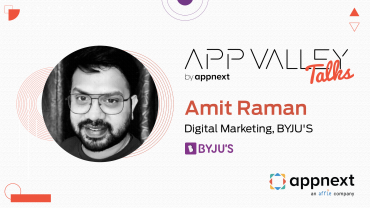Paul Teresi, Skyscanner digital media exec, will guide us through Skyscanner’s unique, scientific hacks of working towards sustainable app growth.
Skyscanner, a leading global travel search site, is a place where people are inspired to plan and book direct from millions of travel options at the best prices. It serves 60M customers every month globally, in over 30 languages and 70 currencies.
Check out the talk below:
Video Highlights:

What is your role at Skyscanner, and what is the company doing in order to reach sustainable app growth?

My role within Skyscanner is Digital Media Executive, and I work solely in our paid growth side of things, working on user acquisition. Internally, we have a couple of different titles, and the big one is growth executive and growth hacker. We are growth a hacking organization using the sensibilities there and so together at Skyscanner we are leading travel metasearch engine that compromises flights, hotels, and car-hire searches, helping users find the best travel solutions for their needs. So together, it is my job to really help focus on our mobile app and make sure that we are bringing the best users who are going to really engage the product and ultimately just make it a nice, simple experience. Travel booking in the past has not necessarily been the most user-intuitive, so making sure that users are able to book their travel whenever they want, where they want, that is kind of the main focus for us.

What is unique about Skyscanner?

I think what is really unique about Skyscanner is that we have a lot of direct partnerships and that gives us a lot of direct content that users are able to leverage.

How does Skyscanner manage to stand out in the travel industry?

With our partnerships, we go directly back to different airlines, hotels, online travel agencies, etc. so we are really able to give users a really comprehensive mix, making them feel comfortable, trustworthy, giving them a lot of sources and options and just take the pressure off of it and really help them focus on their overall trips. We also have great customer support side of things there, so we are really able to offer users a really well-rounded opportunity in travel experience.

Do you think that this industry has its own characteristics when it comes to user behavior?

I think it is really interesting because there are a couple different ways that travel stands out. Specifically on the app front of things.

What is unique in the customer journey of travel apps as opposed to other services?

Apps like gaming or eCommerce maybe have a bigger or shorter dormancy period where they may give users a faster life-cycle there, whereas in travel we might really engage with the user at the beginning and then we have not necessarily lost that user but they are just not ready to book their next trip. So it is making sure you are able to decipher that, and I think a really interesting thing as well is users in the past really looked on their mobile phones just to figure out research, but then they go to another device. They would go to the web and their desktop computers to do the booking, so it is really interesting and a challenge to make sure that you are trying to give the users the best experience at the palm of their hands. And to make them feel comfortable enough that they are able to book their entire travel experience right from their phones.

So, your users are not looking for other apps? Do they stay within your app and do everything there?

We give users all the options and then we provide them the partners and then they are able to go there. But, some features that we have been adding on now include direct booking, which allows users to have the opportunity to book directly with our partners, the airlines, the online travel agencies, from their phone without having to leave the app, making it very seamless for them.

A known problem every app marketer faces is how to re-engage users. What do you think of re-engagement?

I think re-engagement itself is a really big issue. A lot of different advertisers and companies are trying to figure out right now is how to really get those users on the acquisition front.

How is this done at Skyscanner?

One thing that Skyscanner is doing that is really unique is that we are trying to make sure we are giving users experiences before, during, and after the whole bookings side of things. So we have some really cool features like the travel wallet, which allows users to input their frequent flyer numbers, their passport information in a secure setting so they are able to have that at the palm of their hands when they are checking in places. They will have that information accessible as well as with our recent partnership and affiliation with Trip.com. We are going to be able to start giving users more UGC, more content that they are going to be able to engage with after they book their experience as they get hyped up and ready for their trip.

So, you're saying it's a lot of trial and error until you find the right way and it changes every time?

The things to be conscious of is that failure is not a bad thing. And making sure you are able to learn from those mistakes is important. Everything is not going to work out: you are going to have ideas that may be out of reach but once you are able to find something that is working for you, and if you test fast and you test small, then you are able to amplify it. Those are where you are going to find those real pockets of gold, but just understanding that maybe if you did fail, understand why and how you can pivot or persevere from that to really kind of get those actionable targets you are looking for.

You are concentrating your efforts on growth and the ways to “hack it.” How are you doing it, and what are the ways to achieve it?

The big thing for us and how we focus is making sure that we are applying strong scientific experimentation to our user acquisition, so that we are able to grow at scale and that it is sustainable and that we are able to continue these growth trajectories.

What are some of your growth-hacking methods?

The way we do that is making sure that we are hammering it out by having a very concrete hypothesis, knowing exactly what our metrics are, what we really hope to turn, and then making sure we are able to measure that the entire way through. And making sure that it is, at the end of the day, proven and that we are able to say this is because of our test that we ran, making sure that you are eliminating the different noise of seasonality and just making sure you are applying the numbers and everything behind it to really validate everything is one key point.

Do you have any examples?

I think another way to make sure that you are really working on hacking your growth is just making sure that you are looking at user acquisition as a whole and not necessarily siloing out your unpaid, your ASO, and then your paid activities and making sure you find those relationships and those correlations and how you can truly leverage that. That really comes into effect with localization and making sure you understand your markets, the areas of focus, and making sure that if you do find a pocket, how do you capitalize on that in that moment instead of waiting too long, whereas it may have fizzled out. So, it really is just making sure that you’re understanding and digesting your numbers and are able to back up what you are doing.

Is Skyscanner mobile-first?

Mobile first is really our mindsets and that basically translates to our strategy of customers-first, so customers are engaging with this product and they are engaging on the web. In 2016, about 61% of our traffic came via mobile, so there is that switch that I mentioned earlier about users researching on their own then going to desktop.

How do you make sure your users will get the perfect experience and get targeted at the right time?

You know they really engage on their mobile devices, so it is making sure that you are setting them up to have the best features available and having full support there. For a lot of markets we are active in, we have done user acquisition (+35 to be more accurate). A lot of these markets are not only app-first but they are app-only, so we really have adopted a look to Asia, and look to China approach to make sure that we are able to give that attention that they are doing over there to our strategies globally.

So you actually look to see what the right moments are for you to target those users?

Exactly, in those micro-moments and then giving that exclusive content and features of our mobile device, so that users are able to see that it is not just necessarily an app they would engage with when trying to book travel, but rather an app that you would engage with when you are just trying to book your travel between the entire funnel, from your exploration to inspiration to actually getting ready to go there and get notifications about trip delays and those types of things and where to eat or where to go.

What in your opinion is one thing Skyscanner does better than the competition?

I think that one really unique aspect about Skyscanner that sets us apart is basically our technology, it is all self-built. About 50% of our spending goes towards technology and that is at the same level as major companies like Linkedin, Facebook. So we are self-building our products up and then we are able to really localize that. So by making sure that we are getting a true product that is going to have multiple currencies and languages supported and making sure that that is always going to be at the forefront of how we operate and by having that self-built and not relying on third parties, we are really able to change fast, grow fast, and get new features or jump on board of new technology formats right when they are coming out.

Many companies are adopting AI and other new technologies to better serve their customers. Can you tell us if this is something Skyscanner is also considering?

It’s a really exciting aspect and something that we are doing at Skyscanner. So in Feb. 2016, we were the first travel metasearch to actually have skills and tools for Cortana, and for Skype.Within the Skype bot, we are able to have group booking functionalites, which is exciting.
We also have a Facebook Messenger tool, so we are really adopting that by being the first-to-market,and testing it out. Since then we have actually had over 500,000 users really engage with this product, so it’s really exciting and just the growth that’s coming is going to continue, and it’s really going to be a forefront.

Skyscanner must have loads of interesting data, from user preferences to airplane fares in many countries and perhaps can even predict trends. Can you share some interesting insights with us?

I think it’s a really interesting area, and I think for us, making sure that we’re kind of just focusing on how we can really make the user’s journey as seamless and easy as possible will all fall into place. But making sure that online, when the user comes to us, they are always going to feel comfortable with booking online, booking from their devices and providing just the most seamless opportunities available for them.




Comments are closed.